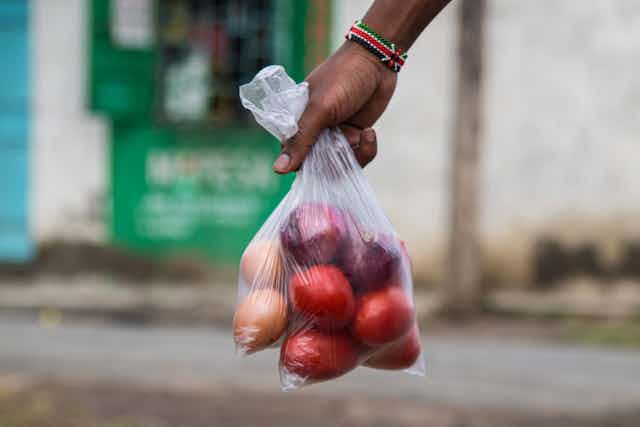Kenya banned the use of plastic carrier bags in 2017, prompted by environmental and health costs. At the time, more than 100 million single-use plastic bags were handed out every year, making them the most commonly used carrier bags for shopping. Most traders and end users have complied with the ban, but the bags have never been completely eliminated. Jane Mutheu Mutune, who researches on environmental governance and management, reflects on the policy hits and misses – and the opportunities to do better.
Why were plastic carrier bags banned and what are the penalties?
Discarded plastic carrier bags were a visible problem across Kenya. This was not just a menace to the environment – it also contributed to health issues for both inland and aquatic animals. Human health was affected, too. Plastic bags clogged water drains and proliferated mosquito-borne diseases like malaria, and the burning of plastic bags has been associated with the release of chemicals with carcinogenic effects. A study sanctioned by the National Environment Management Agency in 2018 found that 50% of livestock slaughtered in Nairobi’s abattoirs had ingested plastic bags.
The ban came with a jail term of four years or a fine of Sh4 million (US$29,300) for offenders. Initially, the ban was greeted with cynicism because the government had tried before to ban plastic bags. A ban that targeted lightweight carrier bags with a thickness of less than 30 microns proved hard to regulate. The current ban covers all single-use plastic carrier bags. However, it exempts materials used for industrial primary packaging, disposable bags for handling of biomedical and hazardous waste, and garbage bin liners.
The Kenya Association of Manufacturers had opposed the ban on the grounds that it would wipe out 60,000 jobs. The association claimed at the time that the ban would force the closure of 176 manufacturers and deny the country revenue from plastic bag exports.
No proper structures of monitoring were put in place to track the environmental benefits of banning plastic carrier bags for an accurate before-and-after picture. This lack of scientific evidence makes it harder to monitor progress or demonstrate the benefits.
What is the level of compliance?
Plastic carrier bags never really completely disappeared from the start. The government’s own assessment two years after the ban placed compliance at 80%. This was revised to 95% two years later in 2021.
But traders could still access plastic bag carriers six years after the ban. Numerous infringements have been reported from time to time. As recently as April 2023, the Nairobi county government warned about the continued use of banned bags by traders in the capital.
On this evidence, the use of banned bags in petty trade has persisted. My study in 2019 found that small traders in Nairobi’s informal settlement of Kibera continued to use banned bags. These traders included food vendors, petty retailers and wholesalers. At the time, 30% of those interviewed in Kibera supported the ban. In the neighbouring rich suburb of Karen, support stood at 60%.
What must Kenya do to make the policy a success?
Getting rid of plastic carrier bags is just the tip of the iceberg. The ban was partial – affecting secondary packaging only – as manufacturers use plastic packaging for a wide range of consumer goods, such as bread and processed meats.
Plastic bottles used for carbonated soft drinks, fruit juices, dilutable drinks and water are another problem. They were to be banned after the carrier bags, but that has not happened yet due to court cases attributed to inadequate stakeholder consultations. Instead such bottles were prohibited in national parks, forests and beaches in 2020.
As such, plastic pollution remains a challenge. Plastic waste management in Kenya is largely informal – it’s collected by hand, sorted and packed for sale to recyclers. Volumes could increase gradually after the 2019/20 budget provided incentives for plastic recycling by exempting VAT and corporate tax cuts for new recycling plants.
To bolster these efforts, Kenya is also moving towards imposing extended producer responsibility for the waste. This means manufacturers would be made to assume responsibility for the entire life cycle of the plastics they put into the market.
What about bringing the public on board?
Studies have shown that the more times a product can be used, the lower the environmental impact. Therefore, it’s not enough for consumers to switch to reusable shopping bags. They must also commit to reusing them and avoid littering.
A 2021 Kenyan study found that the ownership of reusable bags tripled to 12 bags per household on average since the ban. But consumers were disposing reusable bags too prematurely to achieve the optimal environmental benefits.
Going forward, the government should engage the public more. Change is in the mindset and once you change the mindset, compliance becomes easier. The messaging around the impact of plastic on the environment has to be clear, targeted and justified.
Just as important is environmental education, which is a pathway to attitude change and a sense of responsibility. Environmental education should be integrated in all levels of the education system to raise people’s sensitivity to sustainability concerns. This will create champions and agents of change for sustainable development.
Elmah Odhiambo contributed to the research on which this article is partly based.

